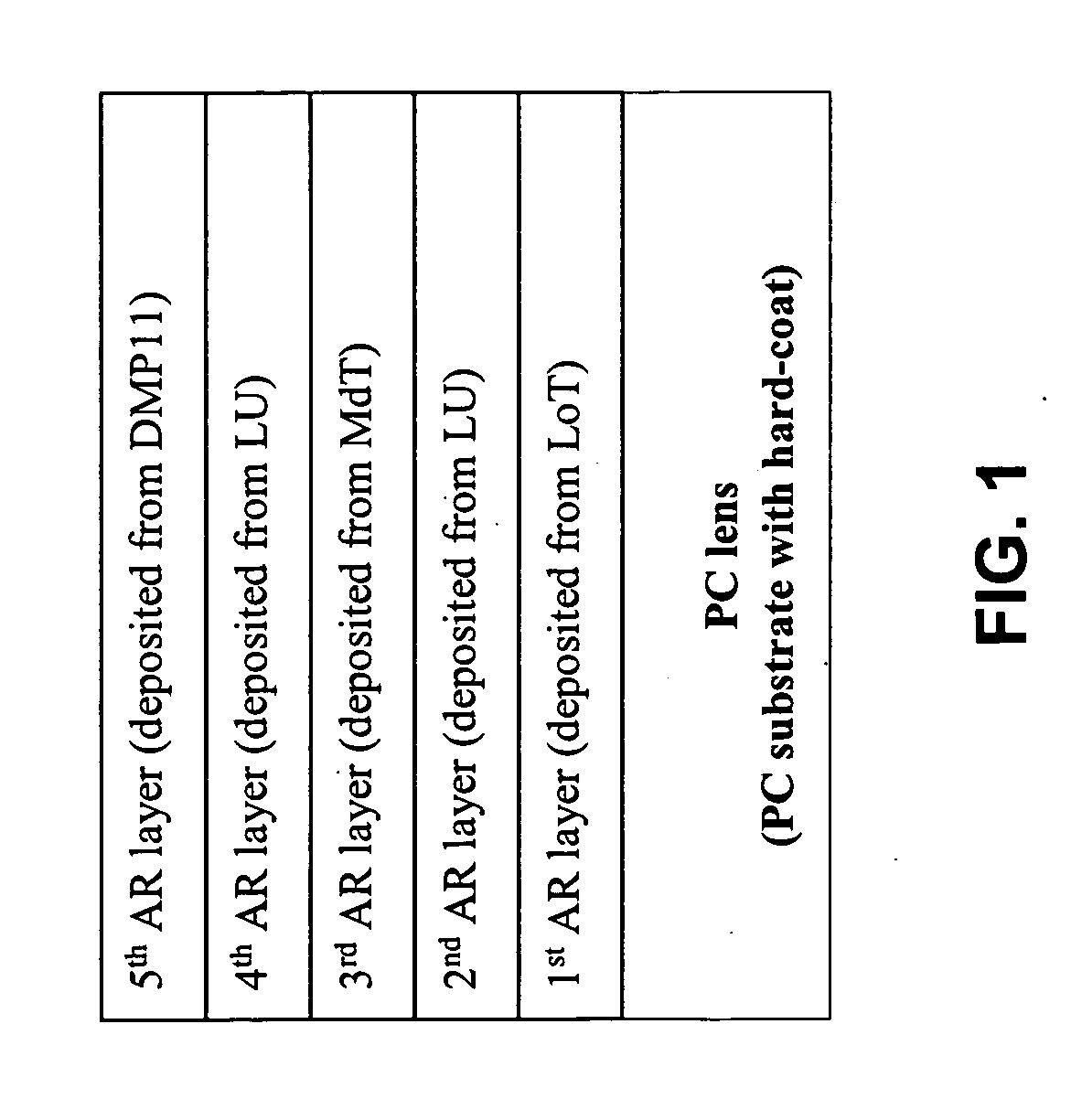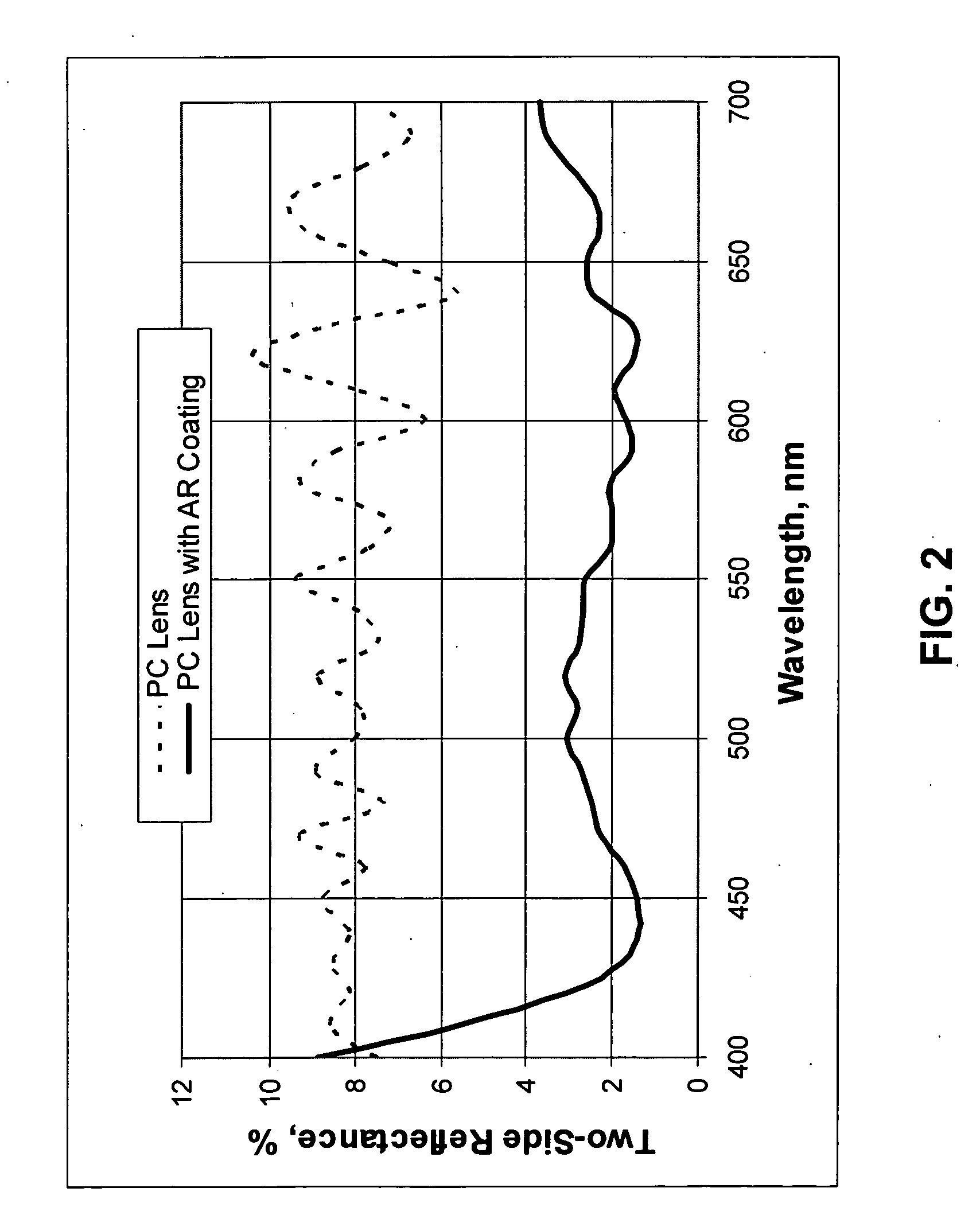Antireflective coating compositions and methods for depositing such coatings
a technology of anti-reflective coatings and compositions, applied in the direction of anti-reflective coatings, instruments, optical elements, etc., can solve the problems of poor adhesion to the underlying substrate, coatings are highly susceptible to mechanical damage, and the use of many applications is not considered to be entirely satisfactory, so as to reduce the susceptibility to mechanical damage and reduce the cost
- Summary
- Abstract
- Description
- Claims
- Application Information
AI Technical Summary
Benefits of technology
Problems solved by technology
Method used
Image
Examples
example 1
Preparation of a Low Concentration Titania Coating Composition
[0068] A low concentration titania coating composition, prepared in this Example, is hereafter designated as the “LoT” composition. The preparation of the LoT composition is described in detail in U.S. Pat. No. 5,856,018 to Chen et al., the contents of which are incorporated herein by reference. This coating composition was prepared as follows:
[0069] In a container, about 317.1 grams of a reagent-grade ethanol (Fisher Scientific, Tustin, Calif., Catalog No. A995-4), about 5.9 grams of hydrochloric acid (about 36 wt % concentrated), and about 5.8 grams of water were mixed for about 5 minutes at about 200 rpm at ambient temperature, to form a first mixture. Then, about 106.4 grams of titanium isopropoxide were added to the first mixture, to form a second mixture. The second mixture was stirred for about 60 minutes at about 200 rpm. Then, about 1552.5 grams of the reagent grade ethanol, about 2.1 grams of the hydrochloric ...
example 2
Preparation of a Medium Concentration Titania Coating Composition
[0070] A medium concentration titania coating composition, prepared in this Example, is hereafter designated as the “MdT” composition. The preparation of the MdT composition is described in detail in U.S. Pat. No. 5,856,018 to Chen et al. This coating composition was prepared as follows:
[0071] In a container, about 448.17 grams of reagent grade ethanol, about 8.31 grams of hydrochloric acid (about 36 wt % concentrated), and about 8.13 grams of water were mixed for 5 minutes at about 200 rpm at ambient temperature, to form a first mixture. Then, about 150.34 grams of titanium isopropoxide were added to the first mixture, to form a second mixture. This second mixture was stirred for about 60 minutes at about 200 rpm. Then, about 1374.52 grams of the reagent grade ethanol, about 2.93 grams of hydrochloric acid, and about 7.61 grams of water were added to the second mixture to form a third mixture. After the third mixtur...
example 3
Preparation of a High Refractive Index Titania Coating Composition
[0072] A high refractive index titania coating composition, prepared in this Example, is hereafter designated as the “HT1” composition. The HT1 coating composition was prepared as follows:
[0073] In a container, about 317.1 grams of reagent-grade ethanol, about 5.9 grams of hydrochloric acid (36 wt %), and about 5.7 grams of water were mixed for about 5 minutes, at about 200 rpm and at ambient temperature, to form a first mixture. Then, about 106.4 grams of titanium tetraisopropoxide were added to the first mixture, to form a second mixture, and this second mixture was stirred for about 60 minutes, at about 200 rpm and at ambient temperature. Then, about 1552.5 grams of reagent-grade ethanol, about 2.1 grams of hydrochloric acid, and about 10.4 grams of water were added to the second mixture, to form a third mixture.
[0074] A fourth mixture was prepared by stirring a solution containing about 1.34 grams of 3-glycidox...
PUM
| Property | Measurement | Unit |
|---|---|---|
| refractive index | aaaaa | aaaaa |
| refractive index | aaaaa | aaaaa |
| refractive index | aaaaa | aaaaa |
Abstract
Description
Claims
Application Information
 Login to View More
Login to View More - R&D
- Intellectual Property
- Life Sciences
- Materials
- Tech Scout
- Unparalleled Data Quality
- Higher Quality Content
- 60% Fewer Hallucinations
Browse by: Latest US Patents, China's latest patents, Technical Efficacy Thesaurus, Application Domain, Technology Topic, Popular Technical Reports.
© 2025 PatSnap. All rights reserved.Legal|Privacy policy|Modern Slavery Act Transparency Statement|Sitemap|About US| Contact US: help@patsnap.com



